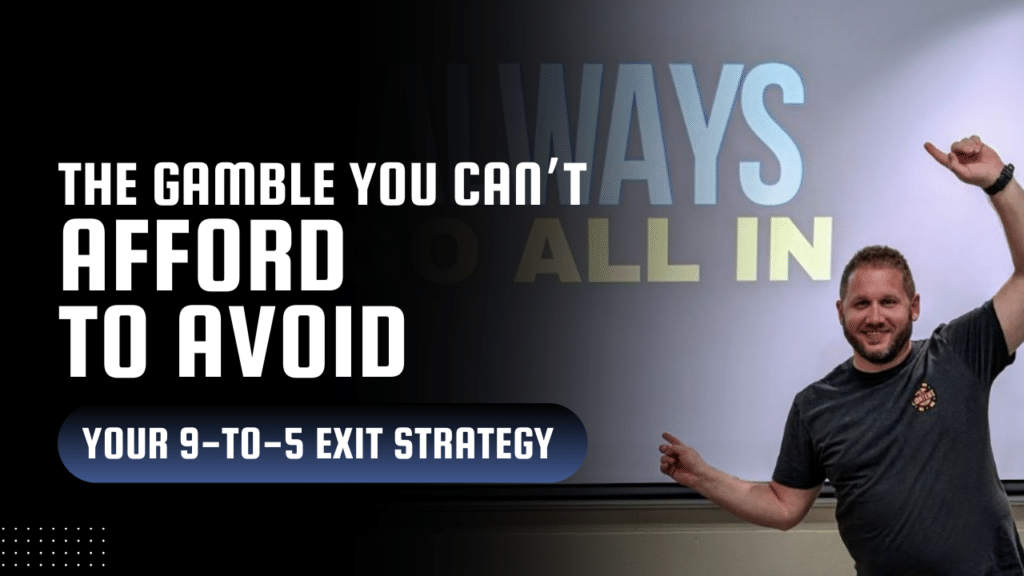If you’re stuck in a soul-sucking 9-to-5, waiting for the “right time” to quit, let me save you some time: there is no right time. There’s only now.
The idea of quitting your job can feel like a gamble—but here’s the truth: staying is the bigger risk. Every day you spend trading your freedom for a paycheck is a day you’ll never get back. So, if you’re serious about escaping the grind and building something meaningful, it’s time to get real about your exit strategy.
Why Quitting Your 9-to-5 Feels So Damn Scary
Leaving a steady paycheck is terrifying for a few reasons:
- Fear of uncertainty: What if it doesn’t work out?
- Financial dependence: You’re used to a predictable income.
- Social conditioning: Society tells you the 9-to-5 is “safe” and entrepreneurship is risky.
But here’s the thing—staying in a job you hate isn’t safe. It’s a slow drain on your happiness, health, and potential.
The True Cost of Staying in Your Job
If you think staying is the safe option, think again. Here’s what it’s really costing you:
- Your time: The most valuable resource you have is slipping away, day by day.
- Your energy: Working a job that doesn’t align with your purpose leaves you drained and unfulfilled.
- Your growth: Sticking to “what’s comfortable” stunts your potential and creativity.
The real gamble isn’t quitting—it’s staying in a life that doesn’t excite you.
Signs You’re Ready to Quit Your 9-to-5
Not sure if it’s time to make the leap? Here are some signs you’re ready:
- You dread Mondays—and pretty much every other day.
- You feel unappreciated, undervalued, or overworked.
- You can’t stop thinking about building something of your own.
- Your passion for your job has completely fizzled out.
If any of this resonates, it’s time to start planning your exit.
How to Build Your 9-to-5 Exit Strategy
Quitting isn’t about diving in blind—it’s about taking calculated risks. Here’s how to prepare for your leap:
1. Define Your ‘Why’
Why do you want to leave? What’s driving you? Write it down. Your “why” will keep you going when things get tough.
2. Create a Financial Runway
Save 6–12 months of living expenses to cover your transition period. This cushion buys you time to focus on building your business without constant financial stress.
3. Test Your Idea
Start your side hustle while you’re still employed. Use this time to validate your idea, refine your offer, and build your audience.
4. Build Momentum
Get as much done as you can before quitting:
- Launch your website.
- Set up systems for invoicing, marketing, and fulfillment.
- Start building a network of clients or collaborators.
5. Set a Quitting Date
Pick a date, mark it on your calendar, and commit to it. Having a deadline creates urgency and accountability.
Overcoming the Fear of Quitting
Fear is normal—but it doesn’t have to stop you. Here’s how to push through:
- Focus on your vision: Keep your eyes on the bigger picture and the life you’re building.
- Start small: Take baby steps toward your goal to build confidence.
- Find support: Surround yourself with people who’ve been where you are and can guide you forward.
The Freedom on the Other Side
Quitting your job isn’t the end—it’s the beginning of something bigger. Here’s what’s waiting for you on the other side:
- Control over your time: No more asking for vacation approval or living for the weekends.
- Work that excites you: Build a business around your passions and strengths.
- Unlimited growth potential: Your success is no longer capped by a corporate ladder.
Freedom isn’t just a dream—it’s a choice.
FAQs
What’s the first step to leaving my 9-to-5?
Define your “why” and start creating a financial plan. Build a side hustle to test your idea before taking the leap.
How much money should I save before quitting?
Aim for 6–12 months of living expenses to cover yourself during the transition.
What if I fail after quitting?
Failure isn’t the end—it’s part of the process. Learn from your mistakes, pivot, and keep moving forward.
How do I know if my side hustle is ready to go full-time?
If your side hustle generates consistent income and you’ve validated demand for your offer, it’s time to consider scaling.
What if my family or friends don’t support my decision?
Explain your vision and why it matters to you, but remember—it’s your life, not theirs. Surround yourself with like-minded people who believe in you.
How do I stay motivated after quitting?
Set clear goals, celebrate small wins, and remind yourself of the freedom and fulfillment you’re building.
Conclusion: A Personal Note from Chris
I remember the day I quit my 9-to-5 like it was yesterday. My hands were shaking as I handed in my resignation, but my heart was pounding with excitement. I wasn’t just leaving a job—I was reclaiming my life.
Was it scary? Hell yes. But staying in a job that drained me felt scarier. I wanted more—more freedom, more fulfillment, more control over my future. And the moment I took that leap, everything started to change.
If you’re sitting at your desk, wondering if there’s more to life than this, let me tell you: there is. It’s waiting for you on the other side of that decision.
Take the leap. Build your exit strategy. And bet on yourself. Because the only gamble you can’t afford to avoid is the one that leads to the life you’ve always wanted.
You’ve got this.








